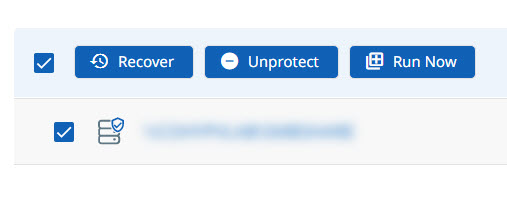Manage Existing Protection
Edit protection settings, change the policy, and start, stop, & pause protection.
Once you have applied protection to the objects in your sources, Cohesity DataProtect as a Service makes it easy to make changes to that protection quickly. You can:
-
Edit additional settings like End Date, Exclusions, Alerts, and more.
-
Apply a different policy.
-
Start an on-demand protection run, pause and resume it, or even remove protection.
Edit Protection Settings
To edit protection settings:
-
In DataProtect as a Service, navigate to Sources.
-
Click into the Source name.
-
Select Show All > Protected and use the other filters, search box, and views at the top to narrow your search.
-
Click the Actions menu (
) next to the object and select Edit Protection to open the protection settings for that object.
Apply a New Protection Policy
To change the Policy, click the drop-down and select a different policy. To help you choose, each policy in the list shows the Backup frequency and the Retain period for each backup.
If you don't have a policy that meets your needs, scroll to the bottom of the list and click Create Policy to create your own policy.
Edit Additional Protection Settings
Under Settings, you can change the protection Start Time (and select the Time Zone).
Click the drop-down next to Additional Settings to change more options. See Additional Protection Settings for details.
Start, Stop, or Remove Protection
When you select protected objects in one of your sources, Cohesity DataProtect as a Service presents buttons for the actions that are possible for those objects.

With the protected objects selected, you can click:
-
Recover to recover the object or file.
-
Unprotect to remove protection from the object.
If a protected object is deleted from the source, you can search the object using Global Search and unprotect it.
-
Run Now to start an on-demand protection run immediately.
Additional Settings
| Advance Settings | Description |
|---|---|
| End Date |
If you need to end protection on a specific date, enable this to select the date. |
| Skip Files on Errors |
(On by default) A protection run continues even if it encounters errors on files, such as permissions errors. If files are skipped, the protection run details page indicates a Warning status and provides additional information. If toggled off, the protection run stops when it encounters an error. |
| Exclusions and Inclusions | By default, all files and folders are included for protection. Use this option if you want to exclude or include specific locations. By creating exclusion and inclusion rules, you can limit the protection to a specific set of files and directories and therefore minimize the disk space used to store the data. |
| Cancel Runs at Quiet Time Start |
(Available only if the selected policy has at least one Quiet Time)SLA When enabled, all the protection runs that are currently executing will cancel when the Quiet Time period starts. By default, this setting is disabled, meaning that after a protection run starts, it continues to execute even when a Quiet Time period starts. However, new protection runs will not start during a Quiet Time. |
|
The service-level agreement (SLA) defines how long the administrator expects a protection run to take. Enter:
|
